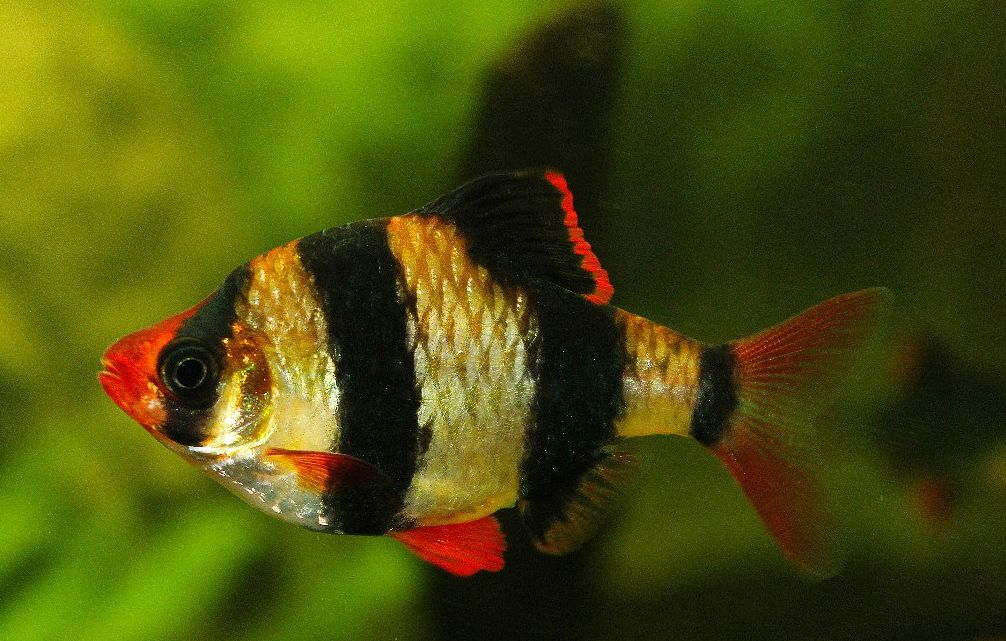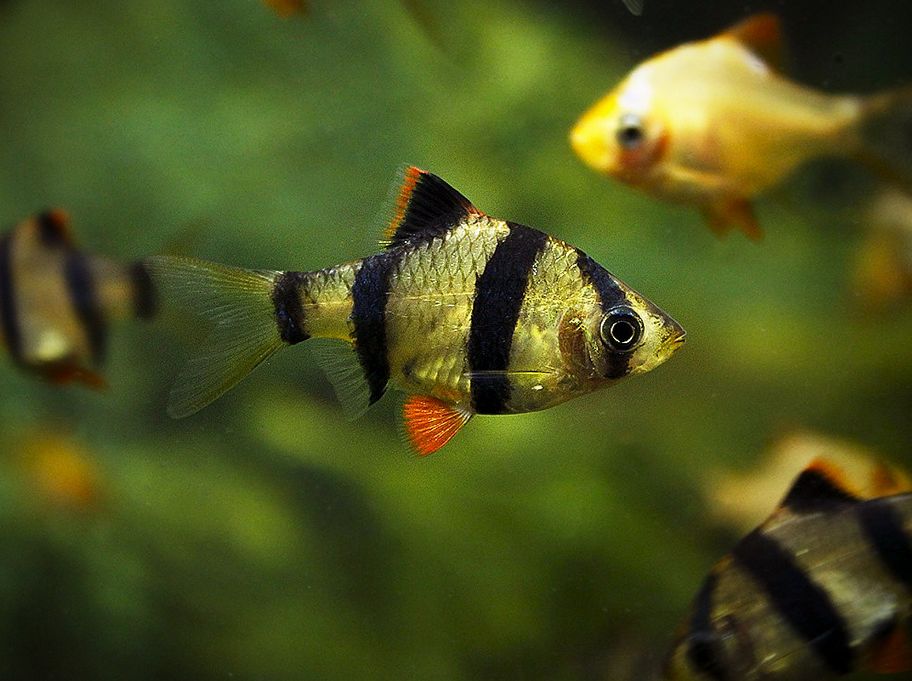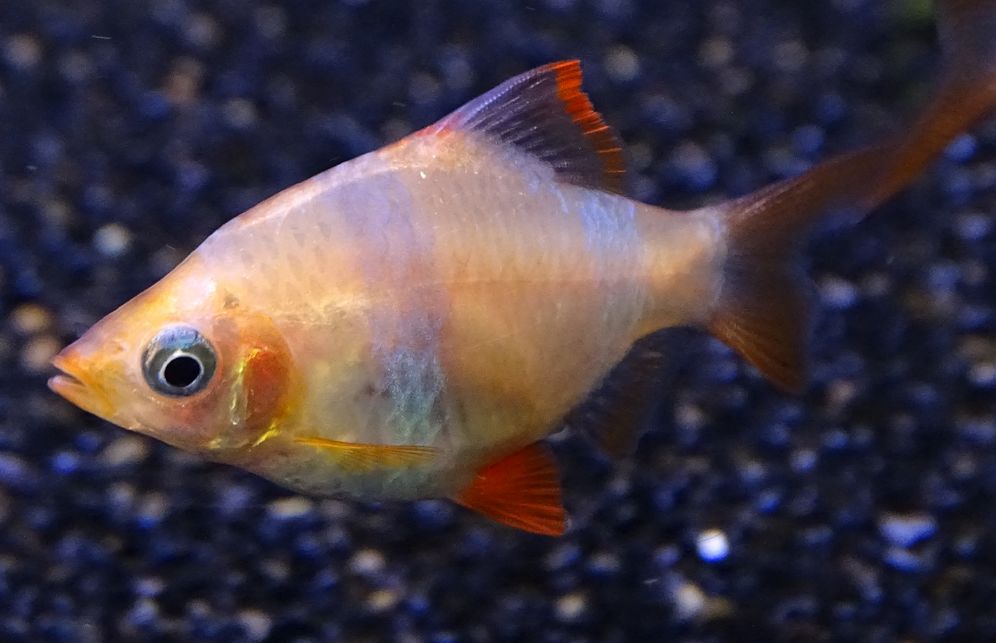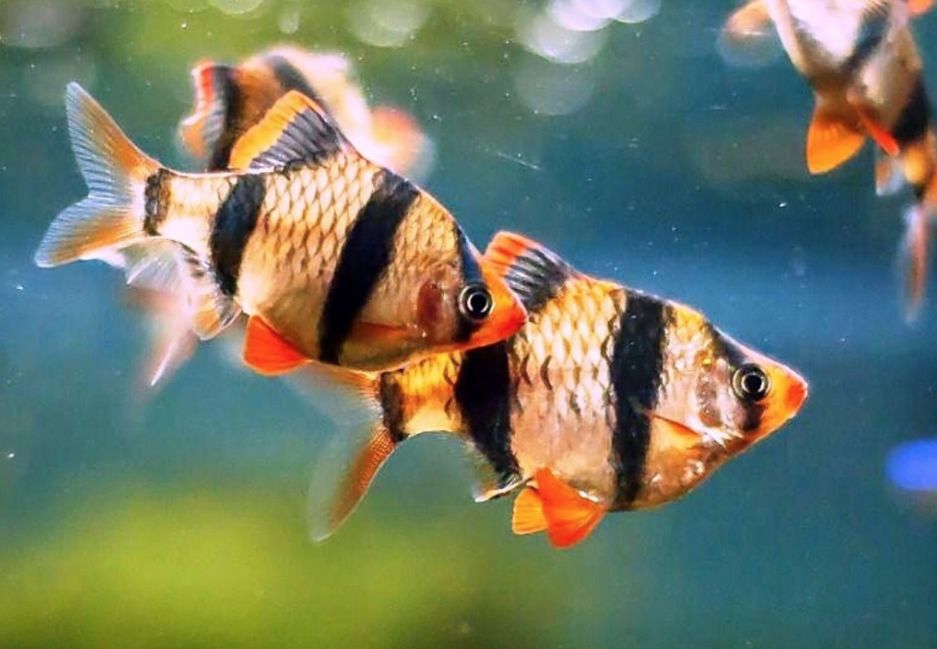The tiger barb is one of the most popular freshwater fish among aquarists due to its vibrant colors and lively behavior. Known for their energetic nature, tiger barbs can bring a dynamic presence to any aquarium. However, their care requires attention to specific needs to ensure a healthy and thriving environment.

Contents
Habitat in the wild
The tiger barb belongs to the family Cyprinidae, commonly referred to as the minnow or carp family. This diverse family encompasses a wide variety of freshwater fish species popular in the aquarium trade, including goldfish, koi, rosy barbs, and danios. Members of Cyprinidae are typically characterized by their small to medium size, laterally compressed bodies, and presence in various freshwater habitats globally.
Native Habitat
Tiger barbs are primarily found in central and southern Sumatra, as well as the Malay Peninsula and Thailand. While their natural populations are localized, some can also be encountered in waters of the USA, Colombia, Suriname, and Australia, often as a result of escape or release from private aquariums. Nearly all tiger barbs available in the aquarium trade are bred in captivity.
Environmental Preferences
In their natural habitats, tiger barbs inhabit slow-moving, heavily vegetated waters such as streams, rivers, and flooded areas rich in aquatic plant life. These environments are typically located in forested or jungle regions. They prefer slightly acidic to neutral pH levels, ideally between 6.0 and 7.5, and thrive in water temperatures ranging from 75 to 82 degrees Fahrenheit (24 to 28 degrees Celsius). Clear, well-oxygenated water is essential, as they are accustomed to flowing conditions, which support their active swimming behaviors.
Description
Body Structure
The tiger barb has a distinctive body shape, characterized by its tall, relatively short frame that is flattened from the sides. The main coloration features a blend of golden and pink hues, while the back displays a darker shade with a slight red tint. The abdomen is yellowish-white, providing a striking contrast.
The head is marked by a brown-red coloration, and four prominent black vertical stripes run along the sides of the body. The first stripe extends along the eye, the second is located behind the pectoral fin, the third is positioned behind the dorsal fin, and the last one is near the fluke.
The dorsal fin has a black base with a striking red top, while the pectoral fins are also red. The remaining fins are typically transparent, sometimes exhibiting a subtle pinkish tint. Selective breeding has led to several variations of the tiger barb. The most common is the green tiger barb, which features a solid stripe instead of the usual four and displays a completely dark green body. Additionally, the albino tiger barb is notable for its light pink body with white stripes and red eyes.
Size
In their natural habitats, tiger barbs typically grow to about 7-10 cm (2.75-4 inches). However, in aquarium settings, their size usually does not exceed 5 cm (2 inches). It is essential to note that individual sizes can vary due to genetics, diet, and environmental conditions. When setting up an aquarium for tiger barbs, it is crucial to provide ample space for their active swimming behavior and ensure they have room to grow comfortably.
Lifespan
In captivity, tiger barbs generally have a lifespan of 5 to 7 years. However, with proper care and a well-maintained aquarium environment, some individuals may live even longer. To promote the health and longevity of your tiger barbs, it’s important to provide suitable water conditions, a balanced diet, and a compatible tank setup. Factors such as genetics, diet, water quality, and stress levels can significantly influence individual lifespans.
| Characteristic | Description |
|---|---|
| Scientific Name | Puntigrus tetrazona |
| Common Name | Tiger Barb |
| Family | Cyprinidae (Minnow or Carp family) |
| Origin | Southeast Asia (Thailand, Malaysia, Indonesia) |
| Habitat | Slow-moving streams, rivers, and flooded areas with vegetation |
| Size | Up to about 2 inches (5 cm) in length |
| Lifespan | Around 5-7 years in captivity |
| Behavior | Active, schooling fish with occasional territorial behavior |
| Tank Size | Minimum of 20 gallons for a small group |
| Water Parameters | pH: 6.0 – 7.5, Temperature: 75-82°F (24-28°C) |
| Diet | Omnivorous, accepts flakes, pellets, live, and frozen foods |
| Coloration | Striking black vertical stripes on an orange or yellow body |
| Compatibility | Can be nippy, best kept with other active fish |
| Breeding | Egg scatterers, require separate breeding setup |
| Special Considerations | Provide hiding spots, avoid keeping with long-finned fish |



Difficulties in keeping
The tiger barb is good for a large number of tanks and it may be kept even by the beginners. It rather easily stands relocation without losing its appetite and activity. However, tank should have clean and well aerated water; not every fish can be tank mate. For example, goldfish will live there in continuous stress.
The same concerns any other long finned fish. The peculiarity of tiger barb temper is that it is a fin nipper. Such behavior is peculiar for not schooling fish, since when the fish is kept in a school it makes it obey the hierarchy and deal with its own kind.
So, our advice is – avoid two things: keeping one or two tiger barbs in a tank and selecting long finned fish as tank mate.
Keeping in a tank
Tank Size
Tiger barbs are active schooling fish known for their somewhat aggressive behavior towards other fish. For a small group, a minimum tank size of 20 gallons (approximately 75.7 liters) is recommended. The tank should be as long as possible to provide ample swimming space, as tiger barbs require room to move. If you plan to keep a larger group or include other species, a larger tank is essential to minimize stress and accommodate their active nature.
When kept in groups of 6 to 8 individuals, tiger barbs display more peaceful behavior, especially if they are well-nourished. In larger groups, their aggression can be distributed more evenly, creating a balanced social dynamic. Tiger barbs are often seen darting around the middle water layer, occasionally freezing in place with their heads down in shaded areas, which is normal behavior and not a sign of illness.
It’s crucial to provide plenty of hiding spots, plants, and decorations. These features enrich their environment and offer refuge for weaker or stressed individuals.
Tank Decor
Creating a suitable tank setup for tiger barbs involves mimicking their natural habitat. Here are some tips for decorating a tank:
- Plants: Incorporate live or artificial plants to provide hiding spots and shelter. Floating plants like water lettuce or hornwort can be beneficial. Ensure there is open space for swimming and shadowed corners for retreat.
- Substrate: Use a fine-grained substrate such as sand or small gravel to resemble their native riverbeds, allowing them to forage for food naturally.
- Hiding Spots: Add decorations like driftwood, rocks, and caves to create territories and hiding spots, helping to alleviate potential aggression.
- Swimming Space: Ensure open areas for darting and swimming; avoid cluttering the tank excessively.
- Current and Filtration: Establish a gentle water current and an efficient filtration system to maintain water quality and mimic their natural habitat.
- Low-light Options: If using live plants, choose species that thrive in lower light conditions, as tiger barbs prefer subdued lighting due to their forested habitat.
Water Parameters
To maintain a healthy environment for tiger barbs, adhere to these recommended water parameters:
- Temperature: 75-82°F (24-28°C)
- pH: 6.0 – 7.5
- Hardness: 5 – 15 dGH (general hardness)
- Ammonia and Nitrite: Should be at 0 ppm (parts per million)
- Nitrate: Ideally kept below 20 ppm
Tiger barbs thrive in warm, slightly acidic to neutral water conditions. Regular water changes and monitoring are essential practices to prevent stress and health issues. Sudden changes in water parameters can be detrimental, so adjustments should be made gradually. It’s also important to renew up to 25% of the tank water periodically to maintain quality and reduce nitrogen compounds that can lead to illness.
Tank Mates
As active schooling fish, tiger barbs should be kept in groups of at least 6. Keeping them in smaller groups can lead to increased aggression, including nipping at the fins of tank mates. While maintaining a school can help reduce their aggressiveness, it does not guarantee complete peace.
When selecting tank mates, choose species that can tolerate their active nature and potential nipping behavior. Avoid slow or long-finned fish, as they may become targets for nipping. Unsuitable tank mates include freshwater angelfish, bettas, goldfish, congo tetras, and dwarf gouramis. Instead, consider keeping tiger barbs with other robust, active species that can handle their playful demeanor.
Here are some compatible tank mate options:
- Other Tiger Barbs: Keeping tiger barbs in a group of at least 6-8 individuals can help mitigate their nipping tendencies. They tend to focus their attention on each other within the group rather than bothering other fish. Males may appear to be aggressive, since they fight with each other, but these fights never end up with the death.
- Fast-Moving Fish: Fish that are similarly active and quick-moving can often do well with tiger barbs. Some suitable options include:
- Bottom Dwellers: Fish that primarily stay near the bottom of the tank can also be good companions for tiger barbs. Consider:
- Peaceful Mid-Level Fish: Some peaceful fish that inhabit the middle levels of the tank can coexist with tiger barbs, including:
- Tetras (such as Neon Tetras)
- Rasboras (like Rasbora hengeli)
Diet
Tiger barbs are omnivorous and can thrive on a varied diet that includes live, plant, and dry foods. A high-calorie diet, however, can lead to obesity, which can have serious consequences. In males, obesity may result in the loss of the ability to fertilize eggs, while females may struggle to lay eggs and could face health issues or even death as a result.
Including plant-based food in their diet helps mitigate the risk of obesity and can also reduce the tendency of adult tiger barbs to nip at tank plants. Additionally, providing live food at least once a week is essential; without this, tiger barbs may become bored and turn to nipping at the fins of less active tank mates. A balanced diet not only supports their health but also contributes to a harmonious tank environment.
Gender differences: male vs female
Identifying male and female tiger barbs can be challenging, especially when they are young or not in breeding condition. Tiger barbs typically reach reproductive maturity at around 6 to 8 months of age, making it difficult to differentiate the sexes prior to this period. However, subtle differences become more apparent as the fish mature and during breeding seasons.
Key Differences
- Head Coloring: One of the most noticeable differences is the male’s head color, which becomes bright red during breeding periods, making it easy to identify when in condition.
- Size and Body Shape: Female tiger barbs are often slightly larger and rounder, particularly when they are carrying eggs. While this difference exists, it can be subtle and may not always be a reliable indicator.
- Color Intensity: Males tend to display brighter and more vibrant colors during breeding, while females may exhibit more subdued hues. However, this distinction may not be very noticeable outside of breeding conditions.
- Behavior: Males engage in more vigorous chasing and courting behaviors during breeding, whereas females may appear less interested in these activities, focusing more on egg-laying.
- Egg Carrying: The most definitive way to differentiate between the sexes is by observing egg-carrying behavior. Female tiger barbs will look plumper with a noticeable round belly when they are carrying eggs, making this an effective method for identification.
If breeding tiger barbs is your goal, closely observing their behaviors during breeding periods will help you identify males and females more accurately. Understanding these differences can enhance your breeding success and ensure the health of your fish.

Breeding
Breeding Age
Tiger barbs reach breeding age at approximately 6 to 8 months. During this period, a female tiger barb can lay around 400 eggs, although some may produce up to 800. The eggs typically hatch within 1 to 3 days, depending on the tank water temperature.
Early Development
Juvenile tiger barbs begin to swim and feed on their own about 3 to 4 days after hatching. By the time they are around 1 month old, they start to develop coloration similar to that of adult fish. Within 2.5 to 3 months, you can reliably distinguish between males and females based on their physical characteristics.
Spawning Tank Setup
For breeding one pair of tiger barbs, a spawning tank with a capacity of 15 liters (approximately 3.96 gallons) is recommended. The setup should include:
- No Bottom Substrate: Place a separator net at the bottom to allow eggs to fall through.
- Plants: Add small-leaved plants for the fish to spawn among.
Water preparation is essential: fill the tank with 50% water from the established tank, 25% fresh settled water, and 25% rainwater or distilled water to lower hardness. The ideal water temperature should be between 25-28 °C (77 – 82 °F).
Selecting Breeding Fish
Choose a female with noticeable bulging in the forepart of her abdomen and the brightest, most active male. It’s advisable for the male to be slightly older than the female. Before spawning, separate the fish for 1 to 2 weeks and feed them nutritious food once a day to prevent obesity.
Introduce the fish to the spawning tank in the evening; spawning typically occurs in the morning and lasts for 2 to 3 hours. Morning sunlight can benefit the spawning process. After spawning, remove the adults and shade the tank while ensuring good water aeration.
Care for Juveniles
Juveniles will hatch within 1 to 3 days and start swimming shortly after. Begin feeding them infusorians and rotifers; after a week, you can introduce small-sized food options.
Coloration and Genetic Traits
When breeding, approximately 75% of the resulting juveniles will share the same coloration as the parents, while about 25% will display typical tiger barb coloration. If one parent is an ordinary color, expect 25-40% of the offspring to be green.
Producing albino tiger barb juveniles is nearly impossible unless one parent is albino, in which case only about a quarter of the offspring may inherit this trait. However, albino juveniles are particularly sensitive to water and food parameters, resulting in higher mortality rates.